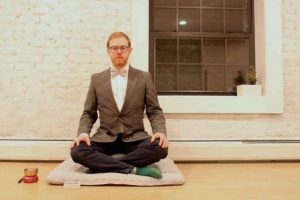
Korean Buddhist monk Venerable Domyeong Sunim announced the publication of a new English-language edition of his book Gaya Buddhism: Unlatching the Gate in Seoul last week, presenting an account of Buddhism’s migration from India to Korea.
The book launch was held at the Indian Cultural Centre in Seoul on 22 September to celebrate 50 years of diplomatic and cultural ties between the two nations. The event was organized by the Indian Embassy and the Gaya Culture Promotion Foundation. The event was attended by several venerable monks, the Indian ambassador to Korea, Shri Amit Kumar, representatives of the Korean government, and several prominent academics.
“I hope that India and Korea can play an important role in enriching human culture by finding lost ancient history,” Ven. Domyeong Sunim, the abbot of Yeoyeojeong-sa, a temple in Korea’s South Gyeongsang Province, said during the event. (Korea JoongAng Daily)
In his book, Ven. Domyeong Sunim explores the theory that Buddhism was introduced to Korea by Princess Suriratna of Ayodhya, who, legend has it, traveled to the Korean Peninsula by sea in 48 CE.
Historical accounts present various theories and routes for the spread of Buddhism to Korea, with some historians disputing the existence of Princess Suriratna due to a lack of evidence.
Ven. Domyeong Sunim said during the launch event that his book was not intended to discount other historical records or interpretations. “My study simply points to the possibility that Buddhism came directly to Korea from India by sea,” he said. (Korea JoongAng Daily)

Princess Suriratna is referenced in the 13th-century Korean chronicle Samguk yusa, which relates that the princess became the wife of King Suro of Geumgwan Gaya (r. c. 42–199 CE) at the age of 16, after arriving from a distant kingdom known as “Ayodhya.”
More than six million people in contemporary Korea trace their lineage to Princess Suriratna, who became Queen Heo Hwang-ok, as direct descendants of her 12 children with King Suro. An ancient tomb in the city of Gimhae, South Gyeongsang Province, is believed to be hers.
The princess and her brother, a monk named Jangyu, are said to have brought a Buddhist monument with them—the Pasa Stone Pagoda—which now stands next to her tomb in Gimhae.
“[Domyeong Sunim’s] book is an invaluable source that stands testimony to the deep civilizational links between ancient India and Korea,” said Ambassador Kumar. “These ongoing exchanges reaffirm the close cultural ties and people-to-people exchanges between our two countries.” (Korea JoongAng Daily)
The book publication and launch was supported by the Delhi-based International Buddhist Confederation, the South Korea’s Foreign Ministry, and the city government of Gimhae.
According to census data for 2021, the majority of South Korea’s population—60 per cent—holds no religious affiliation. Christians make up the largest religious segment of the population at 23 per cent, while Buddhists account for 16 per cent.
* The Korean word “sunim” (스님) is a title of respect used to address or refer to Buddhist monastics.
See more
Publication of the English edition of book ‘Gaya Buddhism, Unlatching the Gate’ (Embassy of India Seoul, Republic of Korea)
Buddhist study highlights Korea’s historical links to India (Korea JoongAng Daily)
Indian Embassy in Seoul organises event to celebrate diplomatic ties between nations (ANI)
Related news reports from BDG
Ven. Pomnyun Sunim Joins Religious Leaders in Interfaith Peace Declaration on 70th Anniversary of Armistice on the Korean Peninsula
Pathways to Peace: Ven. Pomnyun Sunim Delivers Talk on Rising Tensions on the Korean Peninsula
108 Korean Buddhist Monastics Embark on 1,200-km Pilgrimage in India, Nepal
Korean Buddhist Community Plans Restoration of 1,300-year-old Buddha Statue
Ancient Korean Buddhist Text to Be Inscribed on UNESCO Memory of the World Register












